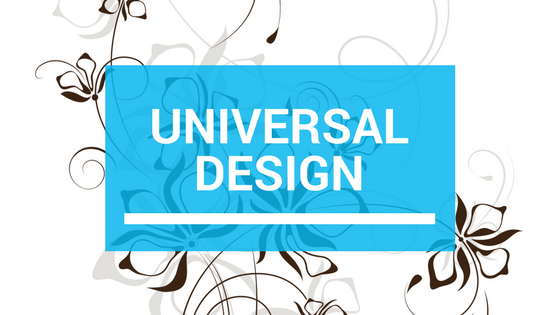
What is Universal Design?
What is Universal Design?
Google Universal Design and you’ll find explanations like this:
“Universal Design is the design and composition of an environment so that it can be accessed, understood and used to the greatest extent possible by all people regardless of their age, size, ability or disability.” (1)
Now let’s put that in lay terms.
Universal Design (referred to as UD) creates environments with people in mind. Instead of residents adapting to how their home is built, the home is designed to adapt to them. This makes it easier for everyone to live in – regardless of age and capability.
In other words, Universal Design is about you.
It evolved in response to the American Disabilities Act (ADA) to accommodate those with movement challenges. Ronald L. Mace, an architect with polio, saw the power of making this design universally available. Because of his experience, he incorporated seven principles that consider how space and products (i.e. thermostats and rocker switches) can be adapted to ease movement and use around the house.
- Equitable Use – Design that’s useful and marketable to people with diverse abilities
- Flexibility in Use – Accommodates a wide range of individual preferences and abilities
- Simple and Intuitive Use – Everything’s easy to understand, regardless of the user’s experience, knowledge, language skill, or current concentration level
- Perceptible Information – Necessary information is communicated effectively to the user, regardless of ambient conditions or the user’s sensory abilities
- Tolerance for error – Minimize hazards and the adverse consequences of accidental or unintended actions
- Low Physical Effort – Everything can be used efficiently and comfortably with a minimum of fatigue
- Size and Space for Approach and Use – Appropriate size and space is provided for approach, reach, manipulation, and use regardless of user’s body size, posture, or mobility
Building with these principles in mind ensures the entire family lives together in the home they enjoy – in ease, safety and comfort.
Traditionally, and still today, homes are built for the “average person” – a 5’10” male between the ages of 20 and 40 with no physical challenges. How many families do you know are comprised of ‘average people’…or even have one member who fits that description?
Here’s why it’s so important…
Think about a child whose head barely reaches the kitchen countertop and is reaching for a plate. Now think about retrieving that plate in an overhead cabinet. You both have the same challenge…and the same opportunity to drop the plate, not only breaking it, but hurting yourself as well.
IDeA Takes It to The Next Level
To make environments and products even more usable, safe, and healthier, the Center for Inclusive Design and Environmental Access (IDeA Center) started an initiative to base design decisions on the latest developments. Just as organizations like the Green Building Initiative (GBI) set standards for sustainable building practices, IDeA developed Eight Goals of Universal Design. These goals, listed below, provide a way to measure how well a UD project uses the best knowledge available:
- Body fit – Accommodate a wide range of body sizes and abilities
- Comfort –Keeping demands within desirable limits of body function and perception
- Awareness – Ensuring that critical information for use is easily perceived
- Understanding – Making methods of operation and use intuitive, clear, and unambiguous
- Wellness – Contributing to health promotion, avoidance of disease, and protection from hazards
- Social Integration – Treating all groups with dignity and respect
- Personalization – Incorporating opportunities for choice and the expression of individual preferences
- Cultural Appropriateness – Respecting and reinforcing cultural values, and the social and environmental contests of any design project
In 2012, combining the goals and principles listed above, Edward Steinfeld and Jordana Maisel expanded the definition of Universal Design to read as follows:
“Universal Design is a design process that enables and empowers a diverse population by improving human performance, health and wellness, and social participation.“
Universal Design and the “Sandwich Generation”

The growing trend in “Sandwich Generation” homes (two or more generations residing under the same roof) demands new strategies. According to Pew Research, a record 60.6 million Americans now live in multigenerational homes. (2)
With increased awareness and new technology, UD continues to be a dynamic process that grows and adapts to our needs as we age. As a result, our human-centered home design levels the playing field for every individual, regardless of our age and ability.
Live easy,
~Jeanette
- https://en.wikipedia.org/wiki/Universal_design
- http://www.pewresearch.org/fact-tank/2016/08/11/a-record-60-6-million-americans-live-in-multigenerational-households/

Pingback: TOE TAG HOMES - So What ARE They? | Design For A Life Span